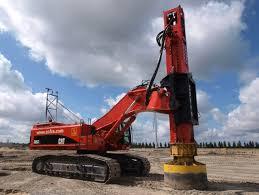Different Types of Pile Driving Hammers Explained in Simple Terms

Every strong structure begins with a solid foundation. Whether it is a bridge, building, dock, or highway, the foundation depends on piles driven deep into the ground for stability. To install these piles, construction teams use an essential tool known as a pile driving hammer.
At Pile Driving USA, we understand that choosing the right pile driving hammer can make a big difference in project speed, safety, and cost. However, many people are not familiar with the different types of pile driving hammers and how each one works.
This article will explain the main types of pile driving hammers in simple, clear terms so you can understand how they function and which one may be right for your next construction project.
What Is a Pile Driving Hammer?
A pile driving hammer is a machine used to drive piles into the ground to support structures like bridges, buildings, piers, or roads. It works by delivering force to the top of the pile, pushing it deep into the soil until it reaches a stable layer that can support the load of the structure.
Different hammers use different methods to generate this force. Some use weight and gravity, others use air, steam, or hydraulic pressure, and some use vibration. The choice of hammer depends on the type of pile, the soil condition, and the specific project requirements.
Why Choosing the Right Pile Driving Hammer Matters
Selecting the correct pile driving hammer is crucial because it affects:
-
Speed of Installation – The right hammer can drive piles faster, saving time and labor costs.
-
Accuracy – A suitable hammer ensures piles are installed straight and at the right depth.
-
Pile Integrity – Using the wrong hammer can damage the pile or cause it to crack.
-
Noise and Vibration Levels – Some hammers are quieter and cause less ground vibration, which is important in urban or sensitive areas.
-
Overall Cost – Efficient pile driving reduces fuel use, maintenance, and delays.
At Pile Driving USA, we help contractors match the correct hammer type to each job to ensure safe, cost-effective, and smooth operation.
The Main Types of Pile Driving Hammers
There are several types of pile driving hammers, each with its own design and working principle. The four most common types are:
-
Drop Hammer
-
Diesel Hammer
-
Hydraulic Hammer
-
Vibratory Hammer
Let’s look at each type in detail.
1. Drop Hammer
The drop hammer is the oldest and simplest form of pile driving hammer. It works on a very basic principle: gravity.
How It Works:
A heavy weight (called the hammer) is lifted to a certain height using a crane or winch, then dropped onto the top of the pile. The impact force drives the pile into the ground.
Advantages:
-
Very simple design with few moving parts.
-
Easy to operate and maintain.
-
Ideal for small or low-budget projects.
Disadvantages:
-
Slow operation compared to modern hammers.
-
Generates loud noise and strong vibrations.
-
Not suitable for very deep or hard soil layers.
Drop hammers are not as common today for large projects but are still useful for smaller or temporary works where speed is not the main concern.
2. Diesel Hammer
The diesel hammer is one of the most widely used types of pile driving hammers in the world. It combines power, reliability, and mobility.
How It Works:
A diesel hammer has a cylinder and piston, similar to an engine. Diesel fuel is injected into the cylinder, where it explodes and pushes the piston upward. As the piston falls back down, it strikes the pile and compresses the air-fuel mixture again, creating a self-sustaining cycle.
Advantages:
-
Very powerful and suitable for most soil conditions.
-
Self-contained system that does not need an external power source.
-
Works efficiently even in remote areas.
Disadvantages:
-
Noisy during operation.
-
Emits smoke and fumes, which may not be ideal in sensitive environments.
-
Requires regular maintenance to keep the engine in good condition.
Diesel hammers remain popular because they provide excellent driving energy and are relatively easy to move and operate on different job sites.
3. Hydraulic Hammer
The hydraulic pile driving hammer is a modern and more environmentally friendly alternative to diesel hammers. It uses hydraulic pressure to drive the pile instead of fuel combustion.
How It Works:
Hydraulic fluid is pumped under pressure into a cylinder, moving a piston up and down. Each downward stroke delivers a controlled impact to the pile head, pushing it into the ground with precision and consistency.
Advantages:
-
Very quiet and produces low vibration.
-
Delivers consistent and controllable striking energy.
-
More efficient and cleaner than diesel hammers.
-
Suitable for urban and environmentally sensitive areas.
Disadvantages:
-
Requires a hydraulic power unit, which adds cost.
-
Needs trained operators to manage hydraulic systems.
Hydraulic hammers are now widely used in modern construction due to their efficiency, control, and environmental benefits. At Pile Driving USA, we provide high-quality hydraulic hammers that meet today’s performance and safety standards.
4. Vibratory Hammer
The vibratory hammer works differently from the other types. Instead of striking the pile, it uses high-frequency vibrations to reduce friction between the pile and the soil, allowing the pile to sink under its own weight or with minimal downward pressure.
How It Works:
A vibratory hammer has rotating counterweights that create vibrations. These vibrations temporarily loosen the soil around the pile, making it easier to insert or remove.
Advantages:
-
Fast and efficient, especially for sheet piles and tubular piles.
-
Very low noise compared to impact hammers.
-
Causes minimal disturbance to nearby structures.
-
Ideal for both installation and extraction of piles.
Disadvantages:
-
Not suitable for very hard or rocky soils.
-
Requires careful setup to maintain control and accuracy.
Vibratory hammers are excellent for marine, waterfront, and urban projects where noise and vibration control are important.
Choosing the Right Pile Driving Hammer
Selecting the best pile driving hammer depends on several factors:
-
Soil Type – Hard, rocky, or dense soils may require impact hammers like diesel or hydraulic. Softer soils are better suited for vibratory hammers.
-
Pile Material – Steel, concrete, and timber piles each respond differently to vibration and impact.
-
Project Location – Urban or environmentally sensitive areas need low-noise, low-vibration equipment such as hydraulic or vibratory hammers.
-
Project Size and Duration – Short-term projects may benefit from renting, while long-term projects may justify purchasing equipment.
-
Budget – Hydraulic hammers have higher upfront costs, but they are more efficient and require less maintenance over time.
At Pile Driving USA, we help clients evaluate these factors and select the most cost-effective and efficient hammer for their specific needs.
Maintenance and Safety Tips
Proper use and maintenance of a pile driving hammer are essential for safety and performance:
-
Inspect equipment before every use.
-
Keep hydraulic and fuel systems clean and leak-free.
-
Train operators on proper handling and safety protocols.
-
Monitor vibration and noise levels, especially in urban areas.
-
Follow manufacturer recommendations for service and parts replacement.
Regular maintenance ensures reliability, extends equipment life, and prevents costly downtime.
Final Thoughts
A pile driving hammer is one of the most important machines in modern construction. From simple drop hammers to advanced hydraulic and vibratory models, each type has a specific role and advantage.


